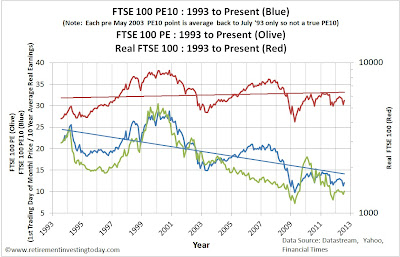This is the Retirement Investing Today monthly update for the FTSE 100 Cyclically Adjusted PE (FTSE 100 CAPE). Last month’s update can be found here.
Before we look at the CAPE let us first look at other key FTSE 100 metrics:
- The FTSE 100 Price is currently 5,608 which is a large 6.6% above the 01 June 2012 Price of 5,260.
- The FTSE 100 Dividend Yield is currently 3.78% having fallen back from 4.00% on the 01 June 2012.
- The FTSE 100 Price to Earnings (P/E) Ratio is currently 10.08 which is up 7.7% since the 01 June 2012.
- The Price and the P/E Ratio allows us to calculate the FTSE 100 As Reported Earnings (which are the last reported year’s earnings and are made up of the sum of the latest two half years earnings) as 556.
Before we look at the CAPE let us first look at other key FTSE 100 metrics:
- The FTSE 100 Price is currently 5,608 which is a large 6.6% above the 01 June 2012 Price of 5,260.
- The FTSE 100 Dividend Yield is currently 3.78% having fallen back from 4.00% on the 01 June 2012.
- The FTSE 100 Price to Earnings (P/E) Ratio is currently 10.08 which is up 7.7% since the 01 June 2012.
- The Price and the P/E Ratio allows us to calculate the FTSE 100 As Reported Earnings (which are the last reported year’s earnings and are made up of the sum of the latest two half years earnings) as 556.




















